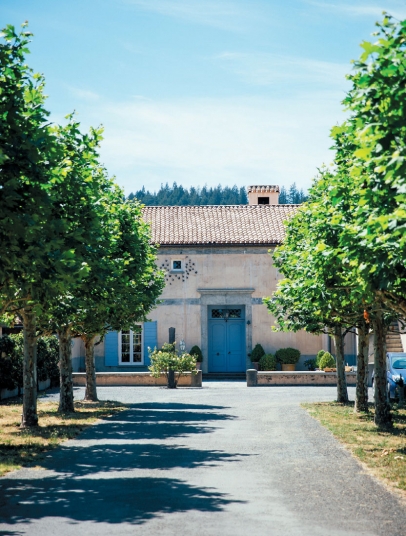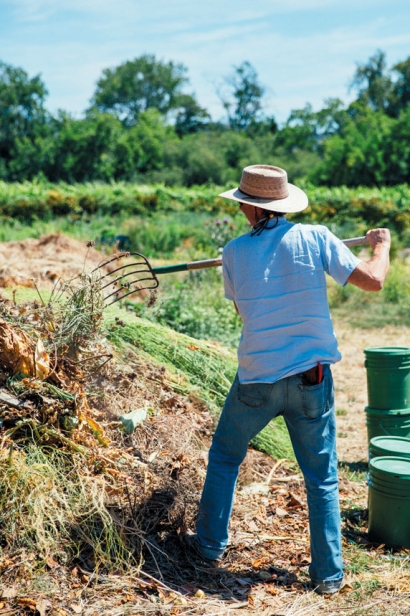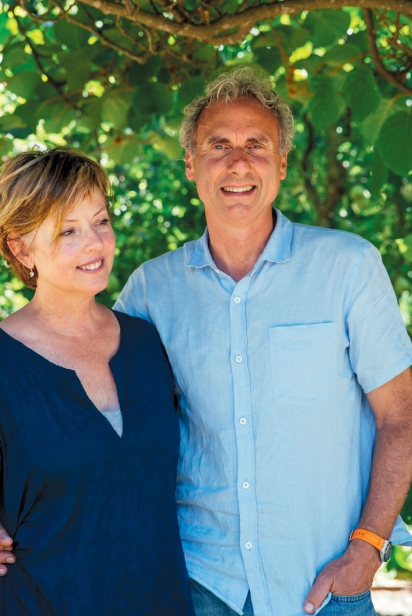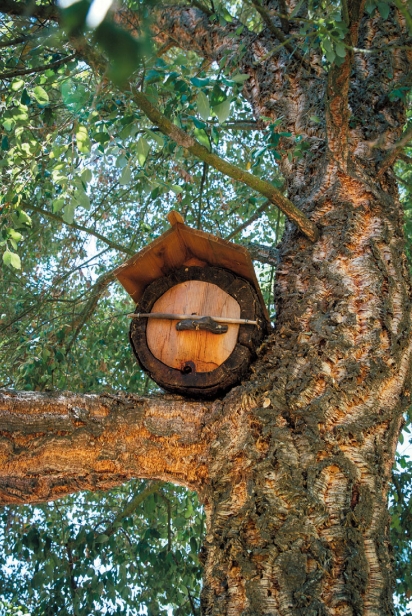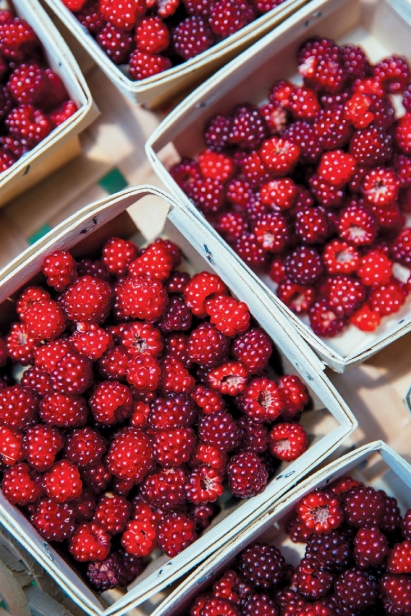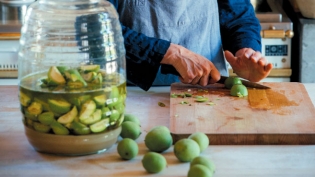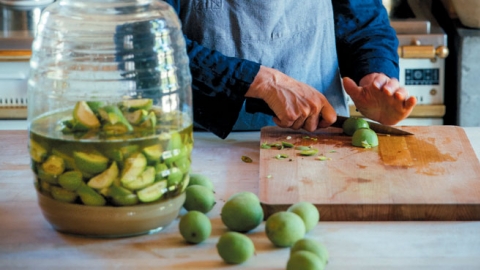Journey to HomeFarm
The Mad Farmer, the Dancer and the Jazz Musician
“The soil is the great connector of lives, the source and destination of all. It is the healer and restorer and resurrector, by which disease passes into health, age into youth, death into life. Without proper care for it we can have no community, because without proper care for it we can have no life.” -Wendell Berry, The Unsettling of America: Culture and Agriculture (Sierra Club Books, 1977)
Doug Lipton and Cindy Daniel’s journey to embrace the soil that became their physical and spiritual home led them to the Dry Creek Valley in 1994. It’s here that they created their HomeFarm, raised their family and recently realized their vision of a building a modern Grange they call SHED in their Healdsburg community. Their journey began in 1980 in Boulder, Colorado.
Doug first spied Cindy a bit beyond the black-capped chickadee he was observing through his binoculars in a tree across the street. It was an ornithology class assignment that led him to the discovery of his future wife sunbathing on a neighboring rooftop. He was mesmerized and happy to have excellent binoculars.
Cindy first saw Doug shoveling manure into a wheelbarrow from the trunk of the avocado green Chevy Malibu that he inherited from his grandmother. As she surreptitiously watched him she felt admiration at his deft handling of manure and wheelbarrow. Additionally, she admired his sartorial creativity; she had never seen someone wear three flannel shirts at the same time. Before they even had their first date she told her mother, “I think I’ve seen the person I could marry.”
Cindy’s mother, Etta Mozingo, was smiling as Cindy shared the story with me during my first visit to HomeFarm. On what turned out to be one of the hottest days of the year, I was grateful to enter the naturally air-conditioned rammed earth farmhouse, where I found Etta (who was visiting) and Cindy sitting in the kitchen at a large, rustic table. They were preparing shiso plums from the orchard to make umeboshi. Hearing Etta’s voice threaded with a Southern accent transported me to my Mammaw’s Alabama kitchen table where the juiciest conversations took place while preparing food.
“Doug’s family is from Louisiana, are y’all from the South as well?” I asked Etta.
“Lafayette, Louisiana,” Etta said as Doug bounded into the kitchen. He chimed in with, “When I found out that Cindy was from Louisiana, I told her I’d finally found my Louisiana Lady,” referencing the early ‘70s song by the New Riders of the Purple Sage. It’s clear that from the beginning Doug knew their partnership was kismet.
Doug’s parents hail from Lake Charles, but they moved to St. Louis where Doug was raised, while still spending summers in Louisiana. I asked Doug and Cindy about their food and land memories of Louisiana. Doug reminisced, “Paw-Paw [his grandfather] took me, my dad, my Uncle and my cousin duck hunting ... I remember the swamps being magical: quiet, water, emergent vegetation, birds, and duck blinds that looked like they were made out of the swamp plants. The bunkhouse where everyone slept had this huge communal table where we all feasted on the most delicious meat I’d ever tasted.”
Cindy asked, “Did you pick dewberries in Alabama?” We fondly remembered this deep purple Southern cousin to the blackberry as a lip-puckering combination of tart and sweet and perfectly designed for children to pick. Later that morning, walking through the gardens and orchards of HomeFarm, I feel their connection to the South thriving in abundant okra patches and fragrant peach trees with names that flow together like a song: Indian Blood, White Lady,
Snow Queen, Elberta, O’Henry, Red Haven, White Tiger, Fairtime, June Pride, Peregrine and Summerset, to sing a few.
Neither Doug nor Cindy dreamed of farming growing up. She wanted to be a dancer and, after a freshman year studying in Southeastern France, she came to the University of Colorado as a dance major. Serious about music, Doug attended Berklee College of Music for a semester, but dropped out and moved to Boulder where he played music for a living and gardened for the communal household where he resided.
Doug loved gardening and became fascinated with soil. From the beginning it was all about the compost. Beat Generation icons Alan Ginsberg and Peter Orlosky (Gingsberg’s longtime partner) would stop by and donate their food scraps while manure cakes dried on the kitchen windowsill. Wendell Berry’s The Unsettling of America: Culture and Agriculture had been out a few years and “The Mad Farmer” Berry’s voice resonated with Doug’s own concerns about how we were living on the planet and what had happened to our farms and our food. Doug decided to go back to school at the University of Colorado to study soil.
Cindy found that Doug’s passions inspired her as well. “Doug was a great gardener. He turned me on to compost, Wendell Berry and food co-ops. He started Boulder’s first storefront food co-op in downtown Boulder [in 1980] and convinced the university’s student council to put $10,000 toward the establishment of the co-op in return for students getting a discount.” This was the time of the Whole Earth Catalog, Mother Earth News, Foxfire and Organic Gardening magazine—all assisting and urging a new generation to become producers and protectors instead of consumers.
Cindy saw this ethos modeled by her mother. “She gardened and enjoyed making things and sewed all of our clothes. You would see us in our beautiful little outfits and matching hats.” Etta explained that she taught herself to sew by reading books. “I told all of my children that you can learn to do anything by reading books, I guess now it would be by reading it on the internet,” Etta laughed, “but you can always teach yourself new things.”
This “back-to-the-land” movement reflected the dawning realization that humans needed to take action to protect our environment, food supply and own well-being as individuals and community. In the words of Berry, “We are going to have to gather up the fragments of knowledge and responsibilities that have been turned over to governments, corporations and specialists, and put those fragments back together again in our own minds and in our families and household and neighborhoods.”
When Cindy and Doug finished their studies in Boulder, Doug decided to study agriculture, in “the belly of the big ag beast” as he calls it, at the University of Missouri in Columbia. Columbia revealed itself to be more progressive than Boulder in many ways. While Doug worked on his master’s in soil chemistry, Cindy was doing the 30-minute Feminist News show on KOPN community radio. She even danced on the radio. According to Cindy, “It was broadcast live from the station, which had a very lively experimental music scene. Sensors were attached to our bodies so that movement generated sound.”
It was a vibrant time as Doug studied permaculture and Cindy shared that, “I was also working on a County Energy Project where we did workshops on energy conservation, weatherized low-income housing, and where finally I headed up the Rodale Cornucopia Project, a nationwide study of the states’ food systems. It was 1981 and I was researching without a computer ways to determine food miles from various reports.”
In 1983, they moved to San Francisco where Doug managed produce at the iconic Rainbow Grocery, worked for Nematode Farm in Silicon Valley and consulted on methane digesters in Marin County. Cindy opened a shop called Telaio (meaning “loom” in Italian) near Zuni Cafe and focused on linens and unique items that would generate an artful thoughtfulness to a home or a table around which family and community would gather. Her curator’s eye and experience in creating the magic of hospitality would stand her in good stead as they later built their Home- Farm and then SHED, their vision of a place where farming, cooking, eating and connecting community would come together.
Two years later, Doug was offered a project at Kibbutz Yagur, which had the largest dairy farm in Israel. “The anaerobic digester research facility there developed methods for recycling dairy manures into energy [methane gas] and into organic liquid and solid fertilizers from the digested and composted waste,” Doug told me.
Cindy teased, “I was working in the kitchen where women with large, strong arms stirred huge vats of mush with cigarettes dangling from their lips.”
Doug said, “Yes, we sold all of the [Grade] A and B produce and used the C or less to feed ourselves.”
Cindy laughed and shared, “Yes, but the nicest thing for me was Doug coming home in the evening looking buff and hot and scented with compost.”
1990 was a landmark year for the Daniel-Lipton partnership. Back in San Francisco, after being “virtually married” for 10 years, they were “officially” married. Doug received his PhD in environmental chemistry with an emphasis on soil chemistry from UC Berkeley. He became principal scientist for an environmental consulting company and later segued into independently running environmental projects and honoring Berry’s proclamation that, “There are no unsacred places; there are only sacred places and desecrated places.”
Restoration requires imagination in the way that Berry describes it: “It is to see, not passively, but with ... visionary force ... to live from a place without destroying it, we must imagine it ... illuminated by its own unique character and by our love for it.” This also requires imagining for the long term—as Doug has done by directing the Montezuma Wetlands Restoration Project for almost 25 years now. This 3,000-acre project in Suisun Marsh near Rio Vista is restoring subsided lands back to intertidal marsh elevations so that the tides can be returned, creating habitat for dozens of endangered fish and wildlife species. It has taken over two decades to complete the first 500 acres.
Cindy was pregnant with their youngest son and their oldest was 3 when they bought the land that would become the family’s home and farm, thus the name “HomeFarm,” in 1994. It was clearly a place that was open to the affection and imagination of its new proprietors. The 16 acres had primarily grown hay and graciously hosted the winding waters of Crane Creek and Dry Creek. Doug was clear that they didn’t want to approach this as a rigid production farm model. Today you will find 11 acres of arable gardens for the bees, the humans and the soil, in addition to about five acres of native riparian habitat alongside the two creeks. There is a natural flow from one growing area to another with a swale that eases through the property guiding excess rainwater to the creeks. Doug emphasized how much he has listened to the land and gone with the flow of what makes sense.
Today he works the land with the help of Alvaro Sayago and his father-in-law, Inocensio Gonzalez. Cindy says that Alvaro and the farm have grown up together because he started there 13 years ago at the age of 19.
Entering HomeFarm there is an effortlessness and beauty to the design that makes one forget the deeper practicalities of rammed earth walls, solar panels that provide 50 % of their power, a 100-gallon compost tea brewer, or a favorite spot for Doug in the garden where he grows soil in compost heaps fed daily by SHED’s kitchen scraps.
The first things they planted were the large kitchen garden and the orchard that includes fruit trees as well as cork, pecans, walnuts and chestnuts. On my second visit I found Cindy again at the kitchen table, this time cutting green walnuts to make Nocino, an Italian green walnut liqueur traditionally prepared on June 24, San Giovanni’s Feast Day. One of the rewards of making a long-term commitment to a place is the ability to keep traditions over time and do things like making your own balsamic vinegar, or honoring the memory of a magical evening at Chez Panisse by growing Muscat grapes and producing their own HomeFarm dessert wine.
Cindy and I talk about the table as the heart of the home, the altar to the farm, to the land, the place we sit and prepare food with a loved one, sharing our thoughts. A place we sometimes adorn with linens and flowers and special plates to elevate, alter and eventually “altar” the space to honor something or someone special. As Cindy said, “We are calling people to bring their whole selves to the table, the meal, the gathering.”
For rural and agrarian communities, gathering at the table to exchange ideas, support each other and celebrate the land that feeds us was at the heart of the founding of the Grange movement in 1867. With the opening of Healdsburg SHED in 2013, Cindy and Doug wanted to create a modern Grange Hall honoring our agrarian past through the use of the shape of a soaring barn, as well as the “now” in the use of recycled steel, an homage to the practical Butler buildings seen on many modern farms. Winner of a 2014 James Beard Award for restaurant design, SHED is a restaurant, market and a gathering place hosting well over 100 workshops and events each year. Cindy says, “This venue is meant to honor Healdsburg’s rich agrarian history while celebrating the farmers, artisans, artists and so many other folks who make our area such an immensely satisfying place to live.”
Lou Preston of Dry Creek Farm and Winery is widely revered as a “farmer’s farmer.” Preston and his wife, Susan, came home to their land in 1973 and now the family stewards a diverse organic and bio dynamic farm and winery in Dry Creek Valley that “grows” soil for their grains, grapes, greens and more. Lou is a big fan of what Cindy and Doug have created.
“Susan and I have known Doug and Cindy for years, originally as fellow farmers and caring fellow residents of Dry Creek Valley, but most recently as fervent food and farming activists. They both have a vision and even better they have a sense of what is achievable, how to give shape and form to ideas. SHED is the embodiment of Doug and Cindy’s vision, a tangible dream that our communities can be resurrected around food and respect for our land and the environment. More than a store, it is a gathering spot for caring people and focal point for creative energies. We all eat, but how many of us acknowledge that we are what we eat? Doug and Cindy are helping us to reclaim that truth. I believe that SHED, with the leadership of Doug and Cindy, will help to define the new Healdsburg. More than a wine- centric town, it will regain its rightful place as a farming community and the expression of man’s partnership with the soil.”
Evan Wiig is the executive director of The Farmers Guild, which supports and connects the “newest wave” of agriculturalists. When I ask him about the couple, Evan says, “Cindy and Doug are helping to incubate a new generation of farmers and agrarians and SHED is a valuable hub for education, access to our products and building community. Through their scholarship programs, buying our products at a fair prices [95% of all the produce at SHED is sourced from farms 10 miles away or less] and supporting our new ‘Follow the Rooster’ project [which helps to identify businesses like theirs who directly support our farmers and help build a better food system, one action at a time], Cindy and Doug offer solutions and hope.”
What of the dancing and the jazz? After Cindy and a business partner sold their Healdsburg yoga studio, the new owners started a dance company. “For the past two years they have choreographed special pieces for SHED, and it’s been my pleasure to support them—they’re really talented ... and what a fantastic thing to have a dance company residing in Healdsburg. Now if I could just make time to take their classes,” Cindy effuses.
Doug has never stopped playing his guitar and his two greatest inspirations are Miles Davis and Bill Frisell. He plays regularly with his Dry Creek Trio and at home with his grown sons, Oliver (a dedicated full-time drummer) and Henri, who plays guitar like his father and works for a literary magazine in San Francisco.
I went to see Doug and Cindy one evening as the DC3 (Dry Creek Trio) played on the patio over the banks of Foss Creek at SHED. Like HomeFarm, SHED has a meandering quality, yet a clear thoughtfulness of placement meant to encourage the connection of good farming, good cooking and good eating. Cindy danced from person to person as Doug played set after set of jazz that both Miles and Bill Frisell would have loved. All in the spot they had imagined into reality as friends and visitors shared the communal table by the Fermentation Bar and ate and drank the bounty of the farms that were lovingly tended to by their neighbors and brought forth to this table.


